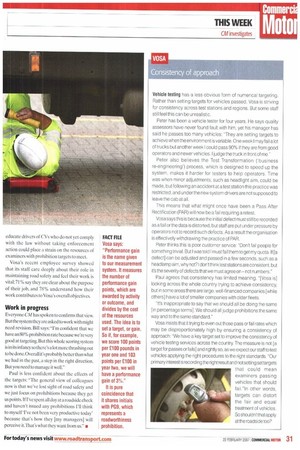Consistency of approach
Page 31

If you've noticed an error in this article please click here to report it so we can fix it.
Vehicle testing has a less obvious form of numerical targeting. Rather than setting targets for vehicles passed, Vosa is striving for consistency across test stations and regions. But some staff still feel this can be unrealistic.
Peter has been a vehicle tester for four years. He says quality assessors have never found fault with him, yet his manager has said he passes too many vehicles: They are setting targets to achieve when the environment is variable. One week I mayfail a lot of trucks but another week I could pass 90% if they are from good operators and newer vehicles. I judge the truck in front of me."
Peter also believes the Test Transformation ('business re-engineering') process, which is designed to speed up the system, makes it harder for testers to help operators. Time was when minor adjustments, such as headlight aim, could be made, but following an accident at a test station this practice was restricted, and under the new system drivers are not supposed to leave the cab at all.
This means that what might once have been a Pass After Rectification (PAR) will now be a fail requiring a retest.
Vosa says this is because the initial defect must still be recorded as a fail or the data is distorted, but staff are put under pressure by operators not to record such defects. As a result the organisation is effectively withdrawing the practice of PAR.
Peter thinks this is poor customer service: "Don't fail people for something trivial. But I was told I must fail them to get my quota. If [a defect] can be adjusted and passed in a few seconds, such as a headlamp aim, why not? I don't think test stations are consistent, but it's the severity of defects that we must agree on -not numbers."
Paul agrees that consistency has limited meaning. "[Vosa is] looking across the whole country trying to achieve consistency, but in some areas there are large, well-financed companies [while others] have a lot of smaller companies with older fleets.
it's inappropriate to say that we should all be doing the same [in percentage terms]. We should all judge prohibitions the same way and to the same standard."
Vosa insists that it trying to even out those pass or fail rates which may be disproportionately high by ensuring a consistency of approach: "We have a key target set to improve the consistency of vehicle testing services across the country. The measure is not [a target for passes or fails] and rightly so, as we expect our staff to test vehicles applying the right procedures to the right standards. "Our primary interest is recording the right result and not setting settargets — that could mean examiners passing vehicles that should failln other words, targets can distort the fair and equal treatment of vehicles. So shouldn't that apply at the roadside too?
























































































































































































